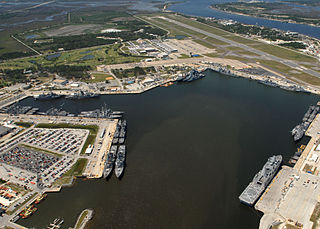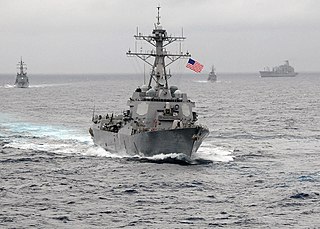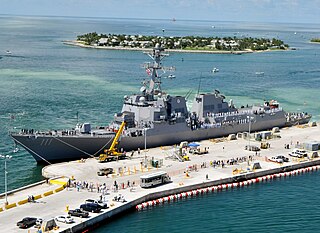
The Arleigh Burke class of guided-missile destroyers (DDGs) is a United States Navy class of destroyer centered around the Aegis Combat System and the SPY-1D multi-function passive electronically scanned array radar. The class is named for Admiral Arleigh Burke, an American destroyer officer in World War II and later Chief of Naval Operations. With an overall length of 505 to 509.5 feet, displacement ranging from 8,300 to 9,700 tons, and weaponry including over 90 missiles, the Arleigh Burke-class destroyers are larger and more heavily armed than many previous classes of guided-missile cruisers.

USS Arleigh Burke (DDG-51), named for Admiral Arleigh A. Burke, USN (1901–1996), is the lead ship of the Arleigh Burke-class guided-missile destroyers. She was laid down by the Bath Iron Works company at Bath, Maine, on 6 December 1988; launched on 16 September 1989; and commissioned on 4 July 1991.

Naval Station Mayport is a major United States Navy base in Jacksonville, Florida. It contains a protected harbor that can accommodate aircraft carrier-size vessels, ship's intermediate maintenance activity (SIMA) and a military airfield with one asphalt paved runway (5/23) measuring 8,001 ft × 200 ft.

USS The Sullivans (DDG-68) is an Arleigh Burke-class Aegis guided missile destroyer. She is the second ship of the United States Navy to be named for the five Sullivan brothers – George, Francis, Joseph, Madison, and Albert Sullivan, aged 20 to 27 – who lost their lives when their ship, USS Juneau, was sunk by a Japanese submarine in November 1942 in the Naval Battle of Guadalcanal. This was the greatest military loss by any one American family during World War II.

USS Barry (DDG-52) is an Arleigh Burke-class guided missile destroyer, commissioned in 1992. Barry is the fourth United States Navy ship named after the "Father of the American Navy", Commodore John Barry (1745–1803). Her homeport is Naval Station Everett, Washington. Several improvements over Arleigh Burke exist on this ship and all following Arleigh Burke-class destroyers, such as the ability to refuel a helicopter.

USS Donald Cook (DDG-75) is an Arleigh Burke-class guided missile destroyer in the United States Navy named for Medal of Honor recipient Donald Cook, a colonel in the United States Marine Corps. This ship is the 25th destroyer of her class and the 14th of the class to be built at Bath Iron Works in Bath, Maine. Construction began on 9 July 1996, she was launched and christened on 3 May 1997, and on 4 December 1998, she was commissioned at Penn's Landing Pier in Philadelphia, Pennsylvania.

USS Carney (DDG-64) is the 14th Arleigh Burke-class destroyer in the United States Navy. The ship is the first to be named after Admiral Robert Carney who served as Chief of Naval Operations during the Eisenhower administration.

USS Porter (DDG-78) is an Arleigh Burke-class destroyer in the United States Navy. Porter is the fifth US Navy ship to be named after US Navy officers Commodore David Porter, and his son, Admiral David Dixon Porter. This ship is the 28th destroyer of her class. Porter was the 12th ship of this class to be built at Ingalls Shipbuilding in Pascagoula, Mississippi. She was laid down on 2 December 1996, launched and christened on 12 November 1997, and commissioned 20 March 1999, in Port Canaveral, Florida.

USS Oscar Austin (DDG-79) is an Arleigh Burke-class destroyer in the United States Navy. Oscar Austin is named for Medal of Honor and Purple Heart recipient Private First Class Oscar P. Austin. This ship is the 29th destroyer of her class. USS Oscar Austin was the 17th ship of this class to be built by Bath Iron Works in Bath, Maine, and construction began on 9 October 1997. She was launched and christened on 7 November 1998. On 19 August 2000 she was commissioned at Bath, Maine. As of July 2021 the ship is part of Destroyer Squadron 2 based out of Naval Station Norfolk.

USS Lassen (DDG-82) is an Arleigh Burke-class guided missile destroyer in the United States Navy. She is named for Medal of Honor recipient Commander Clyde Everett Lassen. This ship is the 32nd destroyer of her class. Lassen was the 14th ship of this class to be built by Ingalls Shipbuilding at Pascagoula, Mississippi, and construction began on 24 August 1998. She was launched and christened on 16 October 1999. On 21 April 2001, she was commissioned at the Florida Aquarium Pier in Tampa, Florida.

USS Pinckney (DDG-91) is an Arleigh Burke-class destroyer in the United States Navy. She is named for African American Officer's Cook First Class William Pinckney (1915–1976), who received the Navy Cross for his courageous rescue of a fellow crewmember on board the aircraft carrier Enterprise (CV-6) during the Battle of Santa Cruz.

USS Momsen (DDG-92) is an Arleigh Burke-class destroyer in service with the United States Navy. Momsen is the twenty-sixth destroyer of the Arleigh Burke class to be built by Bath Iron Works. She is named after Vice Admiral Charles B. "Swede" Momsen of Flushing, Queens, New York (1896–1967). Vice Admiral Momsen made many contributions to the navy such as the invention of the Momsen Lung when he was assigned to the Bureau of Construction and Repair. Momsen was also involved in the first successful rescue of a crew of a sunken submarine, USS Squalus, and subsequently supervised the salvage of the boat.

USS Farragut (DDG-99) is an Arleigh Burke-class destroyer in the United States Navy. She is the fifth Navy ship named for Admiral David Farragut (1801–1870), and the 49th ship of the Arleigh Burke class.

USS Gravely (DDG-107) is an Arleigh Burke-class guided missile destroyer in the United States Navy. She is named after Vice Admiral Samuel L. Gravely, Jr. Commissioned in 2010, she has been on several overseas deployments.

USS Jason Dunham (DDG-109) is an Arleigh Burke-class destroyer in the United States Navy. She is named after US Marine Corps corporal Jason Dunham, who was posthumously awarded the Medal of Honor for service in the Iraq War.

USS Spruance (DDG-111) is a United States Navy Arleigh Burke-class destroyer. She is the 61st ship in her class. Spruance is the second ship to be named for Admiral Raymond A. Spruance (1886–1969), who commanded American naval forces at the Battles of Midway and the Philippine Sea. He was later Ambassador to the Philippines. Her keel was laid down on 14 May 2009. She was christened by the admiral's granddaughter, Ellen Spruance Holscher, on 5 June 2010 in Bath, Maine at Bath Iron Works, where the ship was built at a cost of $1 billion. The completed ship left Bath on 1 September 2011 for her commissioning in Key West, Florida on 1 October 2011.

USS Thomas Hudner (DDG-116) is an Arleigh Burke-class destroyer. The $663 million contract to build her was awarded on 28 February 2012, to Bath Iron Works, of Bath, Maine. On 7 May 2012, Secretary of the Navy, Ray Mabus, announced the ship name would be named Thomas Hudner in honor of U.S. naval aviator Thomas Hudner, who was awarded the Medal of Honor for his actions in trying to save the life of his wingman, Ensign Jesse L. Brown, during the Battle of Chosin Reservoir, in the Korean War.

USS Paul Ignatius (DDG-117) is an Arleigh Burke-class destroyer of the United States Navy. She is named for Paul Ignatius who served as United States Secretary of the Navy under President Lyndon Johnson from 1967 to 1969. Ignatius had previously served as a lieutenant in the Navy during World War II. Paul Ignatius is the second of eight planned Flight IIA "technology insertion" ships, which contains elements of the Flight III ships.

Destroyer Squadron 60 is a destroyer squadron of the United States Navy. Destroyer Squadron 60 is one of three U.S. Navy destroyer squadrons permanently based outside the continental United States.

USS Delbert D. Black (DDG-119) is an Arleigh Burke-class destroyer of the United States Navy.






















